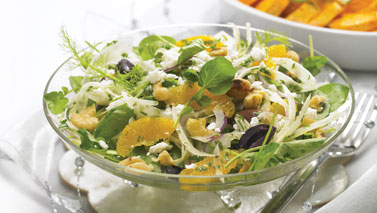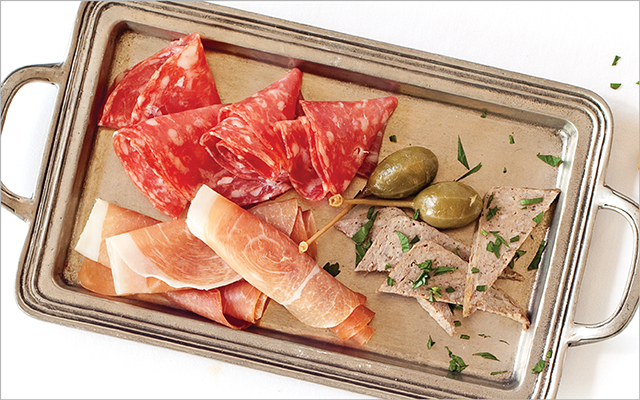I knew things had reached a low point the day my husband offered to pour me a bowl of cereal for breakfast and, while peering into the cupboard, asked: “Do you want sticks and twigs, sticks and berries, or just sticks?”
I decided to take a pass on sticks and devote an extra three minutes to making some steel-cut oatmeal, even if I was just doing it the lazy way — in the microwave. I emptied part of a bag of frozen blueberries into the oatmeal and topped it with milk: Mercy! I suddenly had a delicious breakfast made of real food, not a tragic meal of something that looked like bedding for hamsters. Now that wasn’t that hard, was it?
No, in terms of the cooking and time, it wasn’t hard at all. Conceptually, though, it was sort of tough.
Like so many modern people, I, too, am prone to falling into the trap of thinking that eating healthfully means sacrifice, scarcity and unpleasantness — and, conversely, that eating happily means lying to your cardiologist.
Cookbook author, chef and cooking-school tutor Myra Kornfeld has made a career of trying to show people a third path: “It’s true,” she says. “People do think that something healthy is just going to be sort of sad and not flavorful or fun or luscious. But I don’t think there’s any conflict between luscious eating and healthy eating. That’s why my cookbooks have words like ‘hedonist’ and ‘voluptuous’ in them — people need to know that good food doesn’t have to be monastic.”
Kornfeld, who’s written The Voluptuous Vegan and The Healthy Hedonist, has, for her latest effort, taken on the third rail of American food: the holidays.
I call the holidays the third rail because it seems to me the particular place where ideas of abundance and scarcity clash: If we skip the eggnog, candied yams, appetizers and desserts, we’re “good” — and lonely and deprived. If we have it all, we’re “bad” — though warm, happy and a well-loved part of the celebration. Sound familiar? But Kornfeld insists it doesn’t have to be this hard.
In The Healthy Hedonist Holidays: A Year of Multi-Cultural, Vegetarian-Friendly Holiday Feasts, she puts together elaborate celebration meals for all the big American holidays: Thanksgiving, Christmas Eve and day, Hanukkah, Kwanzaa, New Year’s, and all the rest. These are celebration meals that show a holiday table can be abundant, laden and healthy.
Her version of sweet potatoes, for instance, gets its sweetness from natural potatoes, coconut milk, a little fresh lime juice and a mere tablespoon of maple syrup (recipe below). It relies on the way a sour element like lime juice showcases sweetness as effectively as, say, adding more sweetness with mini-marshmallows.
Kornfeld also shows, through advance-prep time lines, how you can do the cooking for one of those zillion-course extravaganzas that are only possible to pull off during the holidays. More miraculously, she proves that an extravaganza can be healthy. How? Lots of the courses can be beautiful salads and vegetables. And for dessert, a butternut squash pie is Kornfeld’s solution to ending a holiday meal with the rich opulence of a cheesecake — without the heaviness.
“I really do think that part of the equation when you’re eating is how you’re going to feel afterward,” she says. “If you have this nice, delicious meal, but you feel like a brick when you’re done, is that good food?”
Kornfeld is convinced there’s a better way — a more enjoyable way. “We’ve become this culture of black and white: It’s either deprivation or it’s too much. Too often we think deprivation is going to be what saves us, so we ask ourselves: What can we take away? What can we deny ourselves? But if you come from abundance, that’s the key.
I recently talked to someone who had some health issues and lost 100 pounds, but his diet now is so sad it almost makes me cry — nothing but steamed vegetables and boneless chicken breasts. I gave him a copy of my book, and said, ‘You can add some flavor to your life and still be healthy.’ Life and food are not black or white — there’s a big lovely gray in there. There are ways to not deprive yourself, but still find you’re eating really well.”
That’s good news to me, because, truth be told, I never liked those bowls of sticks and twigs. I’d much rather have an abundance of sweet potatoes and salads.
Winter Citrus Salad With Parsley, Fennel and Walnuts
Serves four
- 1 cup red onion, thinly sliced into halved rings
- 4 navel oranges or tangerines
- 1 medium fennel bulb
- 1/4 cup olives, preferably kalamata, halved, or niçoise, whole (optional)
- 1 cup chopped fresh parsley
- 1/2 tsp. salt
- Freshly ground black pepper
- 2 tbs. extra virgin olive oil
- 1/2 cup walnuts
- 1 bunch watercress, washed, with hard stems removed
- 1/4 pound feta cheese, preferably sheep’s milk, crumbled, about 3/4 cup (optional)
Directions
- Soak the onion in cold water for 15 minutes. Drain and dry thoroughly.
- Cut the peel and any white pith from the oranges with a sharp paring knife, then cut the sections free from the membranes, letting them drop into a medium bowl to collect the juices, which will become part of the dressing.
- Add the onions to the citrus.
- Trim the fennel, using a peeler to peel off any discolored parts. Halve the fennel and cut away the hard core. Using a mandoline or a knife, slice the fennel halves very thinly and add it to the citrus along with the olives. If you plan to serve this immediately, stir in the parsley at this point as well.
- Stir in the salt and sprinkle with black pepper.
- Stir in the olive oil and let sit for 30 minutes or so to let the flavors marry.
- In a medium, heavy-bottomed skillet, dry-toast the walnuts until fragrant, about five minutes.
- Rub the walnuts against the strainer (over the sink or wastebasket) to loosen the skins. Remove the walnuts from the strainer and chop into small (1/4-inch) pieces.
- Serve the salad on the watercress, sprinkled with the walnuts and cheese.
Sweet Potato Gratin With Coconut Milk and Chipotle Chile
Serves eight
- 3 pounds sweet potatoes (about six medium), peeled and cut into 1/4-inch rounds
- One 15-ounce can unsweetened coconut milk
- 1/2 chipotle chile in adobo sauce, seeded and minced
- 1 tbs. fresh lime juice
- 1 tsp. salt
- 1 tbs. maple syrup
- 3 garlic cloves, thinly sliced
Directions
- Preheat the oven to 350 degrees F.
- In a medium bowl, mix together the sweet potatoes, coconut milk, chipotle chile, lime juice, salt, maple syrup and garlic.
- Transfer the mixture to a baking dish (8 x 11-inch Pyrex is ideal). Cover with aluminum foil.
- Bake 45 minutes to one hour, until the sweet potatoes are just tender.
- Uncover and bake an additional 30 minutes, or until the tops are browned.
Cherry-Almond Baked Apples
Serves four
- 1/2 cup whole almonds
- 1/2 cup dried cherries
- 1/4 tsp. ground cinnamon
- 1 tbs. almond butter
- 1 tbs. maple syrup
- 1 tsp. vanilla extract
- 1/4 tsp. almond extract
- Salt
- 4 baking apples, such as Cortland, Rome Beauty or Mutzu
- 1/2 lemon
- 1 cup apple juice
Directions
- Preheat the oven to 350 degrees F.
- Dry-toast the almonds in a medium, heavy-bottomed skillet about three minutes, until fragrant and lightly browned. Remove from the heat and chop into small pieces.
- Place in a bowl with the dried fruit and cinnamon.
- Mix together the almond butter, maple syrup, vanilla, almond extract and a pinch of salt in another small bowl. Stir into the nuts just until the mixture is moistened.
- Core the apples and peel a 1/2-inch band of skin around the middle of each apple to prevent them from splitting.
- Rub the peeled area with the cut lemon. Spoon about 3 tablespoons of filling into each apple.
- Place the apples in a baking dish or pie plate and pour the juice on the bottom. Bake, uncovered, until the apples are tender, 45 minutes to an hour, basting every 15 minutes. A teaspoon of lemon or orange zest is a delicious addition.
- Serve warm or at room temperature.
Recipes excerpted from The Healthy Hedonist Holidays by Myra Kornfeld (Simon & Schuster, 2007).





This Post Has 0 Comments